Interview-Ron Haviv, photographer: Photography as an art of engagement
Povezani članci
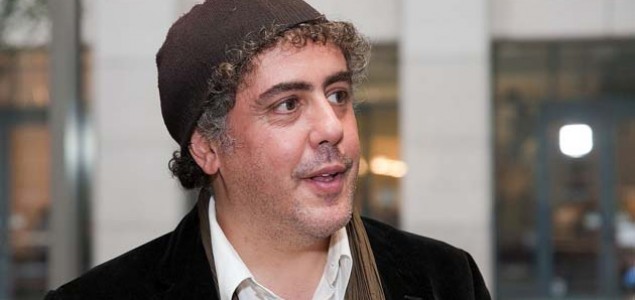
Photo Flickr
Ron Haviv is one of the best photographers in a world. He documented some of the most horrible happenings in last thirty years. His photographs marked one era, and shifted the boundaries of documentary photography turning them into art. For Tačno.net, Haviv speaks about his engagement, position of photography in art history, possibilities of engagement, way that acts of ISIS pushed limits of brutality and future of his art
Interview by: Amila Kahrović-Posavljak
People usually ask you how it feels to be back in Bosnia. And I will ask you, if you would make photos of Bosnia today, what would we see?
I think I would photograph the country at a crossroads, a country that doesn’t know even what its borders will be in five or ten years. And how that feeling seems to be involved in everything from having coffee at the coffee shop to somebody talking about where they want to be in their career in five years or where they want to raise their family.
There is twenty years of distance since you have been here, and during that period world has changed. How has photography as an art changed?
Photography is live art, it is continuously changing and it has been changed by both the audience and by the artist or how do we want to call it. So the language becomes more and more sophisticated. And, in addition, the appreciation of photography has changed dramatically due the technology. The fact that photography is a universal language, and the fact is that many people in the world have a camera in their hands because there is camera in any phone, and they consider themselves photographers to some degree has changed the perspective of photography and has created an incredible amount of imagery. This year, 2015, one trillion of images is going to be created and uploaded to facebook, instagram etc. That is incredible number. And so, there is positive side to that: people are engaged in photography and understanding it in different level. The negative side of that is there are so many images that are impossible for viewer to appreciate because they are constantly seeing images, images, images. The challenge for us as photographers is to rise above with our work and to be able to get to the audience. Those of us who can do that can be very sucessful in getting our stories and messages out. If you can’t rise above it as a photographer, your work will be lost in the masses.
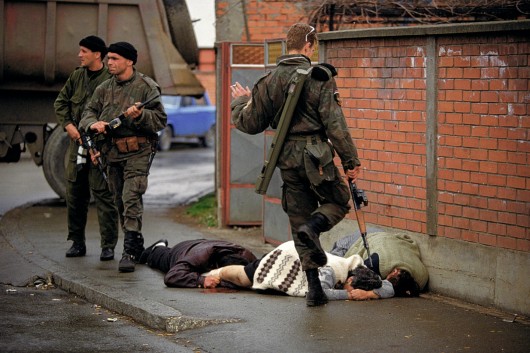
31 March 1992. Serb forces hunt down and kill Bosniak civilians in the city of Bijeljina, Photo: Ron Haviv
Do you think that photography has, because of it’s universal language, highest possibilities for social engagement of all the arts?
I think at this point because of technology of distributions can easily cross borders all photography at this point has best ability to succeed in terms of communication, in terms of people seeing it, in terms of having an affect.
The other side of story can be some kind of loss of power. Can artistic and documentary photography lose it’s power for those one trillion images?
It is a double edge sword, if you are not able to reach your audience, your work will be lost. However, if you are able to reach your audience the power that exists for your work has never existed before on such a level. So, on one level it is very hard to but if you succeed you will do it better than any other photographer before.
How do paparazzi fit in photographing story? Are they criterion of our social consciousness, or is it today for people more important what is going on in some celebrity marriage than in Syria or Darfur?
I don’t think that it is about photography. It is about what are people’s interests, where their tolerance is and where editors of these publications choose to put their effort. They try to satisfy what they think audiences desire is. I think that there is room for both of those worlds to live together. And when you look at the magazines like Paris Match or People magazine, you will see they have celebrities and very light stories and within the magazine there will be a story about Syria or Haiti. I think that it is totally fine, because I think that in the world different interests exist. If the best way of reaching people is by giving them some celebrities and light stories and than the Syria story, and to appreciate all of them, it can be successful formula.
In one interview you sad that you don’t want photographs from Syria to be seen just as another photography from crisis area. Do you think that photography still has power to upset us and make us act?
I think the audience should not be a passive audience. The audience has to learn how to consume and understand photography, especially documentary. So this idea: “Oh there is another picture from Syria and I don’t care”, is not the right attitude. The attitude should be: “I can’t believe after four years I am seeing the same photographs, why is this still happening?” So, I think there is possibility on the side of the photographers, and on the side of the publishers to cause a reaction but people don’t talk of the responsibility of audience. The audience has to be more active and more involved. And if they do that, there will be impact from photography. But if they don’t do that, than it is very difficult. I think that, especially as an American in this post 9/11 world, or I hope as an American, that Americans will understand that things that are going on far away like in Afghanistan or somewhere else can affect you in New York city. People have to understand that we, the world, are more intertwined then ever before. And photography is one of tools to teach us those lessons and to raise awareness of the people to pay attention to what is happening in Syria, or Rwanda or this week in Macedonia because even if you don’t care it might affect you but preferably you would care because of we should consider oursleves being citizens of the world. Photography has the ability to remind people, and reminding people is kind of education that should be happening in the schools here in Bosnia, in New York, in London and other places.

Bosniak civilians imprisoned in the Serb-run Trnopolje concentration camp near Prijedor in 1992; Photo: Ron Haviv
Can you tell us about your experiences in putting pressure on politicians to solve conflicts in area that you photographed?
I look upon my work and work of my colleagues as part of the chain, a very important chain because we find the stories, we document them we put them out in a world and we expect other people to take it to the next level. Next level being politicians, being the public or a combination of the two… But this idea of people saying “Oh, I didn’t do anything because I didn’t know about it” should not be alowed, and photography doesn’t allow it. For instance photography done by a colleague, Marcus Bleasdale done in the DR Congo about mining and it’s impact. The public became involved and says to a company that produces computer chips, which is getting suplies from Congo, STOP. Then this company says ok we have to change our policy about our chips and they say they will no longer take any material from Congo. That is attached to photography motivating people for a pressure to a company that is having actual effect.
Regarding audience. Big philosophical idea is questioning relations of presence and absecnce. So, photography has amazing power of making something present for example Syrian war can become present in my owy or your own house by the photograpghy. What are people’s reactions to this kind of presence?
When?
Whenever…
I think like we have been talking about. Some people react and are motivated to find out something more and to act. Some people ignore it and it doesn’t mean anything to them. Some of it changes as it is continues, people start seeing it and they have to pay attention. Other effects are in combination with other media such as in America with a very famous television and comentator on news. If the media start to talk about it and people see it then hopefully people will pay attention to this. Photography can be simple or complicated. When it is simple it captures everything in one image, and when it is not there is more work and engage to look at the story that photographer is telling. But again it is up to audience that can be active but sometimes it takes time to make them act.
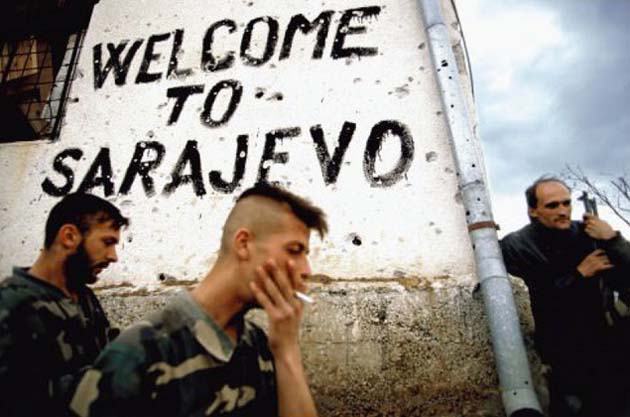 Sarajevo 1994.; Phptp: Ron Haviv
Sarajevo 1994.; Phptp: Ron Haviv
Your photographs from Srebrenica or Bijeljina, for example, when they were taken they were call for action. Now, with time distance, they have turned into places of memory. Is their power increasing as the time passes?
I actually think that, and it is very fascinating for me to see that especially with my works from Bosnia, because my work from Bosnia was ignored when it was first printed and then time is on…
Why it was ignored?
I think it was ignored for the geopolitical reasons at the time and the fact that US and the others were not interested in becoming involved, they basically ignored it. And everyday myself and my colleagues were telling the story that was ignored. But looking back in my work how it has been intertwined with culture here and memorializing what was happening. There was comic strip based on it, there were posters made of it for propaganda and that was very fascinating transformation from news to other lives. What is incredibly interesting to me is the further we get away from the moment the more they become historical documents rather than news images. The images exist in a very different life and are appreciated in a different way and I see this especially with this work, that relationship between the work and the viewer is very different. Of course when you display it in galleries, exhibitions or in a book this relation is very different then when it was in newspapers.
Photographs from crisis area have always been some kind of cry for help. And now we have something different, some kind of pushing limits with the acts of ISIS. They are making photos and videos of their own brutality, so photography has turned from cry for help into some kind of manifestation of brutality. How you explain this?
What ISIS is doing has been growing phenomenon that for me started with Sri Lanka when the government crushed the Tamil Tigers. They did not allow any journalists or photographers. Thousand of people were killed and no one has a complete idea of what actually happened. Two years later Iran had green revolution and all the western journalists were thrown out of the country. And now we fast forward to what ISIS is doing and again there are very few if any journalists allowed and all the visuals are created by them. And what they create is a mix of propaganda, but at the same time it is the only information for us what they are doing. And I am fearful that this is going to become standard way anybody is going to work. It will be a “we don’t need you” attitude. Why was I let into Kosovo or Bosnia? To tell the stories of all the sides. Now it is like “I don’t need you I can tell my story”. And what is going on is again up to the audience. If the audience accepts what they are watching from these sides instead of independent journalism, if they act ok to the message it will not be good. If they pay no attention to those sites, no likes, no views, nothing, then traditional means of communication has future. If audience just wants to see something and doesn’t care is it the ISIS capture or not, then we are all going to basically watch propaganda.
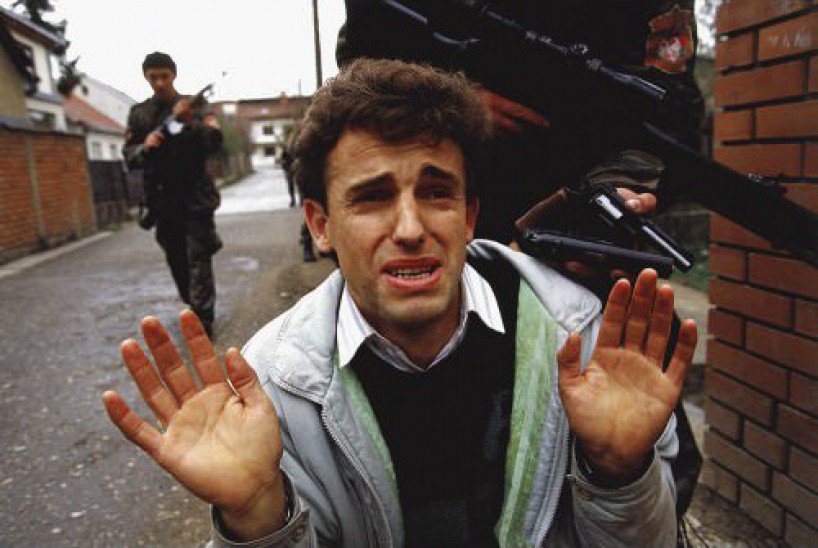 Bijeljina 1992.; pfoto: Ron Haviv
Bijeljina 1992.; pfoto: Ron Haviv
Photographers are usually going to crisis area to show brutality that is hidden. And groups similar to ISIS act as they will show their own brutality, they are proud of it and there is no need for you to show it…
Which is a relatively new and different thing… When we show brutality it should be shocking. What ISIS does, to people it is normal to some degree. What is going on again is the audience and their perception and reaction. This is living thing and we don’t know exactly how to live with that. ISIS actually didn’t create something incredibly unique as we go back to Nazi’s Germany and see they documented everything. It’s that distribution didn’t exist like it does today.
When you go to crisis area, you photograph victims and the criminal, violent one. So you photograph two sides of the same painful story. Is eye of the photographer some kind of metaphor?
I think you could say that it is metaphor for way we see what is happening in front of us. I think that Bijeljina, or prison camps or anything that I photographed here, I was unable to affect anything on the ground in front of me and was very representative of how the West was impotent in their ability to change the reality here for a very long time.
What is interesting to me is place of photography in history of art. Because, photography is younger than many classic arts and also there is fact that it is very usually cry for help or some kind of scream. Can we say that photography is continuing tradition of expressionism which in other arts has ended?
I think that is fair statement to say that it continues the idea, it continues the concept of story telling through a very specific way and it is more obviously comparable with expressionism than literature or painting or etc. It is a new kid on the block, as it is has only been around for a hundred or so years and it is changing dramatically, especially in last five years. So that question is very exciting in terms of a tool and we don’t know what is the next step.
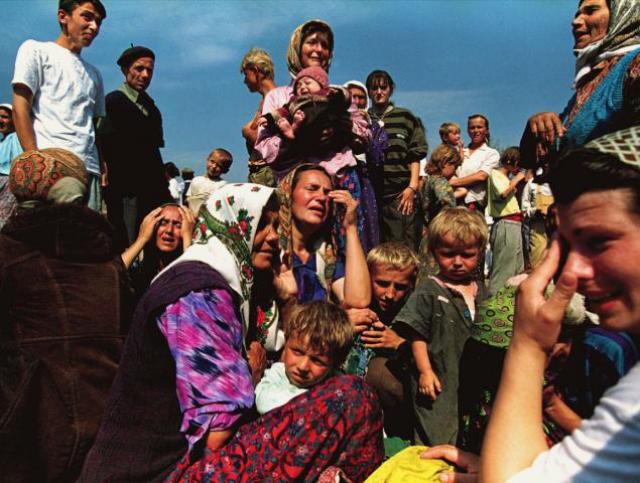
Surivivors of the attack on Srebrenica arrive at a United Nations camp in Tuzla, 1995; Photo: Ron Haviv
What do you think future of engaged photography is? And what are your plans for the future?
The future of engaged photography, in terms of photographers doing it, will always exist. People like myself have this calling to go, document and tell the stories. The power and the success of that will depend on how the audience interacts with that and whether we can find different ways to reach the audience. I think there is a real possibility to continue to do that, to reach more people than we have ever had before but it is going to be difficult and when we are successful it will be very powerful and this is something I will continue to do as photographer. My next projects are all going to try different way to engage audiences, to educate, to inform, to motivate to take action.
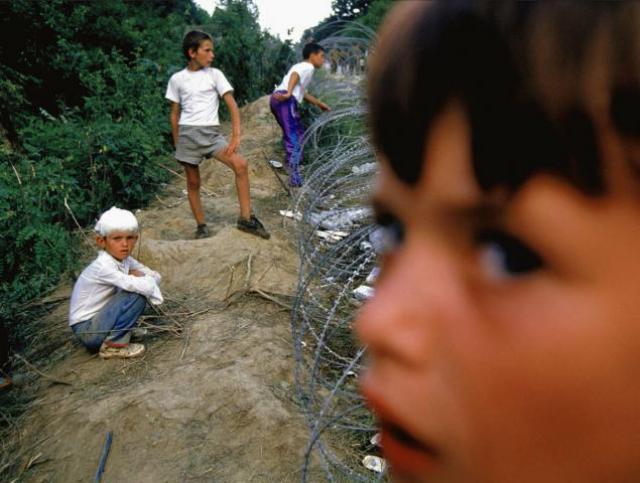
Children who survived the Srebrenica genocide in United Nations camp in Tuzla, 1995; Photo: Ron Haviv


 ENG
ENG





























